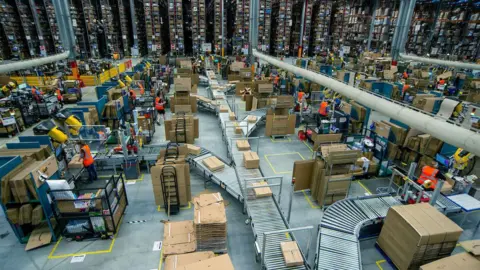By Tom Singleton, Know-how reporter
 Amazon
AmazonThree a long time on from the day it started, it’s arduous to get your head across the scale of Amazon.
Contemplate its huge warehouse in Dartford, on the outskirts of London. It has tens of millions of inventory gadgets, with lots of of hundreds of them purchased day by day – and it takes two hours from the second one thing is ordered, the corporate says, for it to be picked, packed and despatched on its method.
Now, image that scene and multiply it by 175. That is the variety of “fulfilment centres”, as Amazon likes to name them, that it has world wide.
Even if you happen to suppose you possibly can visualise that unending blur of parcels crisscrossing the globe, you should keep in mind one thing else: that is only a fraction of what Amazon does.
It’s also a significant streamer and media firm (Amazon Prime Video); a market chief in house digital camera methods (Ring) and sensible audio system (Alexa) and tablets and e-readers (Kindle); it hosts and helps huge swathes of the web (Amazon Net Providers); and way more apart from.
“For a very long time it has been known as ‘The Every part Retailer’, however I feel, at this level, Amazon is form of ‘The Every part Firm’,” Bloomberg’s Amanda Mull tells me.
“It is so giant and so omnipresent and touches so many various components of life, that after some time, individuals form of take Amazon’s existence in all types of components of day by day life form of as a given,” she says.
Or, as the corporate itself as soon as joked, just about the one method you might get although a day with out enriching Amazon not directly was by “residing in a cave”.
 Getty Photos
Getty PhotosSo the story of Amazon, because it was based by Jeff Bezos in 1994, has been one in all explosive development, and continuous reinvention.
There was loads of criticism alongside the way in which too, over “extreme” working circumstances and how a lot tax it pays.
However the principle query because it enters its fourth decade seems to be: as soon as you’re The Every part Firm, what do you do subsequent?
Or as Sucharita Kodali, who analyses Amazon for analysis agency Forrester, places it: “What the heck is left?”
“When you’re at a half a trillion {dollars} in income, which they already are, how do you proceed to develop at double digits yr over yr?”
One possibility is to attempt to tie the threads between current companies: the huge quantities of procuring knowledge Amazon has for its Prime members would possibly assist it promote adverts on its streaming service, which – like its rivals – is more and more turning to commercials for income.
However that solely goes up to now – what advantages can Kuiper, its satellite tv for pc division, convey to Entire Meals, its grocery store chain?
To some extent, says Sucharita Kodali, the reply is to “hold taking swings” at new enterprise ventures, and never fear in the event that they fall flat.
Simply this week Amazon killed a enterprise robotic line after solely 9 months – Ms Kodali says that it is only one of a “complete graveyard of dangerous concepts” the corporate tried and discarded so as to discover the profitable ones.
However, she says, Amazon might also should give attention to one thing else: the growing consideration of regulators, asking troublesome questions like what does it do with our knowledge, what environmental influence is it having, and is it just too huge?
All of those points may immediate intervention “in the identical method that we rolled again the monopolies that grew to become behemoths within the early twentieth century”, Ms Kodali says.
For Juozas Kaziukėnas, founding father of e-commerce intelligence agency Market Pulse, its dimension poses one other downside: the locations its Western prospects dwell in merely can’t take way more stuff.
“Our cities weren’t constructed for a lot of extra deliveries,” he tells the BBC.
That makes rising economies like India, Mexico and Brazil necessary. However, Mr Kaziukėnas, suggests, there Amazon doesn’t simply have to enter the market however to some extent to make it.
“It is loopy and perhaps shouldn’t be the case – however that is a dialog for one more day,” he says.
 Getty Photos
Getty PhotosAmanda Mull factors to a different precedence for Amazon within the years forward: staving off competitors from Chinese language rivals like Temu and Shein.
Amazon, she says, has “created the spending habits” of western shoppers by performing as a trusted middleman between them and Chinese language producers, and bolting on to that straightforward returns and lightening quick supply.
However take away that final aspect of the deal and you’ll convey costs down, because the Chinese language retailers have achieved.
“They’ve stated ‘properly, if you happen to wait per week or 10 days for one thing that you just’re simply shopping for on a lark, we can provide it to you for nearly nothing,'” says Ms Mull – a proposition that’s interesting to many individuals, particularly throughout a value of residing disaster.
Juozas Kaziukėnas shouldn’t be so certain – suggesting the brand new retailers will stay “area of interest”, and it’ll take one thing way more basic to problem Amazon’s place.
“For so long as going procuring entails going to a search bar – Amazon has nailed that,” he says.
Thirty years in the past a fledging firm noticed rising traits round web use and realised the way it may upend first retail, then a lot else apart from.
Mr Kaziukėnas says for that to occur once more will take an identical leap of creativeness, maybe round AI.
“The one menace to Amazon is one thing that does not appear like Amazon,” he says.




